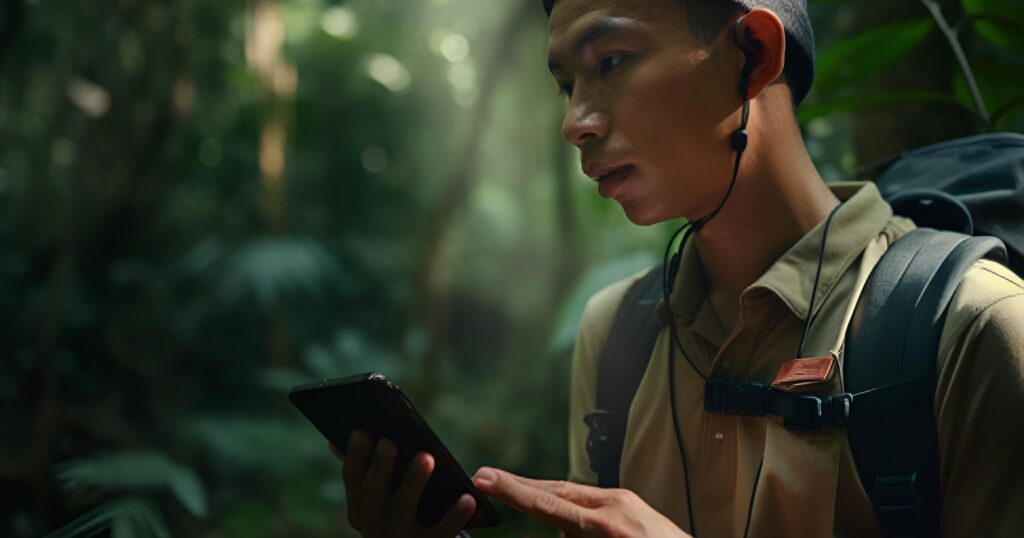- Clearly marked trails provide a sense of direction and can be easy to follow.
- Usually maintained by local communities or park authorities, ensuring safety and accessibility.
- Can be a great way to learn about the local culture and environment through guided trails.
- Wild animals usually avoid trails.
FINDING YOUR WAY THROUGH THE PHILIPPINE WILDERNESS
Navigating through the Philippine wilderness is like trying to solve a complicated puzzle, except the pieces keep moving, the picture keeps changing, and the answer is always "it depends." Here are just some of the challenges of wilderness navigation:
THE OPTIONS
Navigating through the Philippine wilderness can be a challenging task, but fear not! We will explore the top five methods of navigating the wilderness in the Philippines and weigh the pros and cons of each.
1. TRAIL

One of the oldest and most traditional methods of wilderness navigation is following established trails. Many popular hiking destinations in the Philippines have well-marked trails that are maintained by local communities or park authorities. Following these trails can be a relatively safe and straightforward way to explore the wilderness, especially for beginners.
-
Pros
-
Cons
- May not be available in remote or less-traveled areas.
- Trails may be poorly marked or overgrown, making navigation difficult.
- Relying solely on trails can limit the opportunity for exploration and may not provide a true wilderness experience.
2. LOCAL GUIDE ASSISTANCE

Another effective method of navigating the wilderness in the Philippines is to hire a local guide. Local guides are knowledgeable about the terrain, flora, and fauna of the area and can provide valuable insights and assistance in navigating through the wilderness and confusing trails.
-
Pros
- Local guides have expert knowledge of the local environment and can provide valuable insights.
- Can be a valuable resource in case of emergency.
- Can enhance the overall experience by providing cultural context and stories about the area.
- Can help navigate through challenging terrain or areas with no established trails.
-
Cons
- Can be expensive, especially for extended trips.
- May not be available in all areas, especially remote or less-traveled regions.
- Reliance on a local guide may limit the opportunity for independent exploration and self-sufficiency.
Travelers with limited or no navigation skills must stick to the trail and follow the local guide to avoid getting lost.
3. MAP AND COMPASS

For those who prefer traditional navigation methods, using a map and compass can be a reliable way to navigate the wilderness. Topographic maps are available for many popular hiking destinations in the Philippines, and with some basic orienteering skills, you can confidently find your way.
-
Pros
- Maps provide a comprehensive overview of the area, including topography, trails, and landmarks.
- Compasses are reliable and do not require batteries or technology.
- Builds essential wilderness navigation skills that can be applied in various situations.
-
Cons
- Requires learning orienteering skills, which may take time and practice.
- Tall and dense vegetation, such as thick forests or dense jungles, can obstruct visibility, making it difficult to see landmarks, reference points, or features on a map. This can result in difficulty in orienting oneself.
- Quality and detailed paper maps for hiking are not available in Philippine stores. Downloadable topographic maps may be available from government online sources such as NAMRIA, but they are outdated and does not include recent changes in the landscape, such as new trails, roads, or natural features. Outdated maps cause confusion and miscalculation.
- May require carrying additional gear and can be cumbersome.
4. HANDHELD GPS DEVICE

In recent years, handheld GPS devices have become popular tools for wilderness navigation. These devices use satellite signals to provide precise location information, making navigation more efficient and accurate.
-
Pros
- Provides precise location information in real-time, making it easier to navigate in unfamiliar areas.
- Requires no wi-fi connection
- Can store waypoints, tracks, and routes for easy reference.
- Some devices have additional features such as weather updates, altimeter, and compass.
-
Cons
- Requires batteries.
- Can be expensive.
- May have difficulty acquiring and maintaining a strong satellite signal lock in dense tree canopy cover.
- Over-reliance on GPS technology can diminish essential wilderness navigation skills.
5. SMARTPHONE GPS APP

In today's digital age, smartphone GPS apps have become increasingly popular for wilderness navigation. There are many apps available that offer detailed maps, tracking, and navigation features.
-
Pros
- Convenient and easily accessible, as most people carry smartphones with them.
- Provides detailed maps and navigation features that can be updated in real-time.
- Most gps apps have downloadable maps and can be used even without internet connection.
-
Cons
- Requires internet connection to download a map.
- A monthly/yearly subscription may be necessary to unlock map downloads and more premium features.
- Smartphone batteries may drain quickly when using GPS apps.
- May have difficulty acquiring and maintaining a strong satellite signal lock in dense tree canopy cover.
- Smartphones are vulnerable to damage from environmental factors such as water, dust, and impact.





















3 comments
Pingback: 10 Things Foreigners Should Know About Philippine Hiking – peaksify.com
Pingback: Survival by the Clock – peaksify.com
Pingback: 10 Survival Myths That Can Get You Killed – peaksify.com